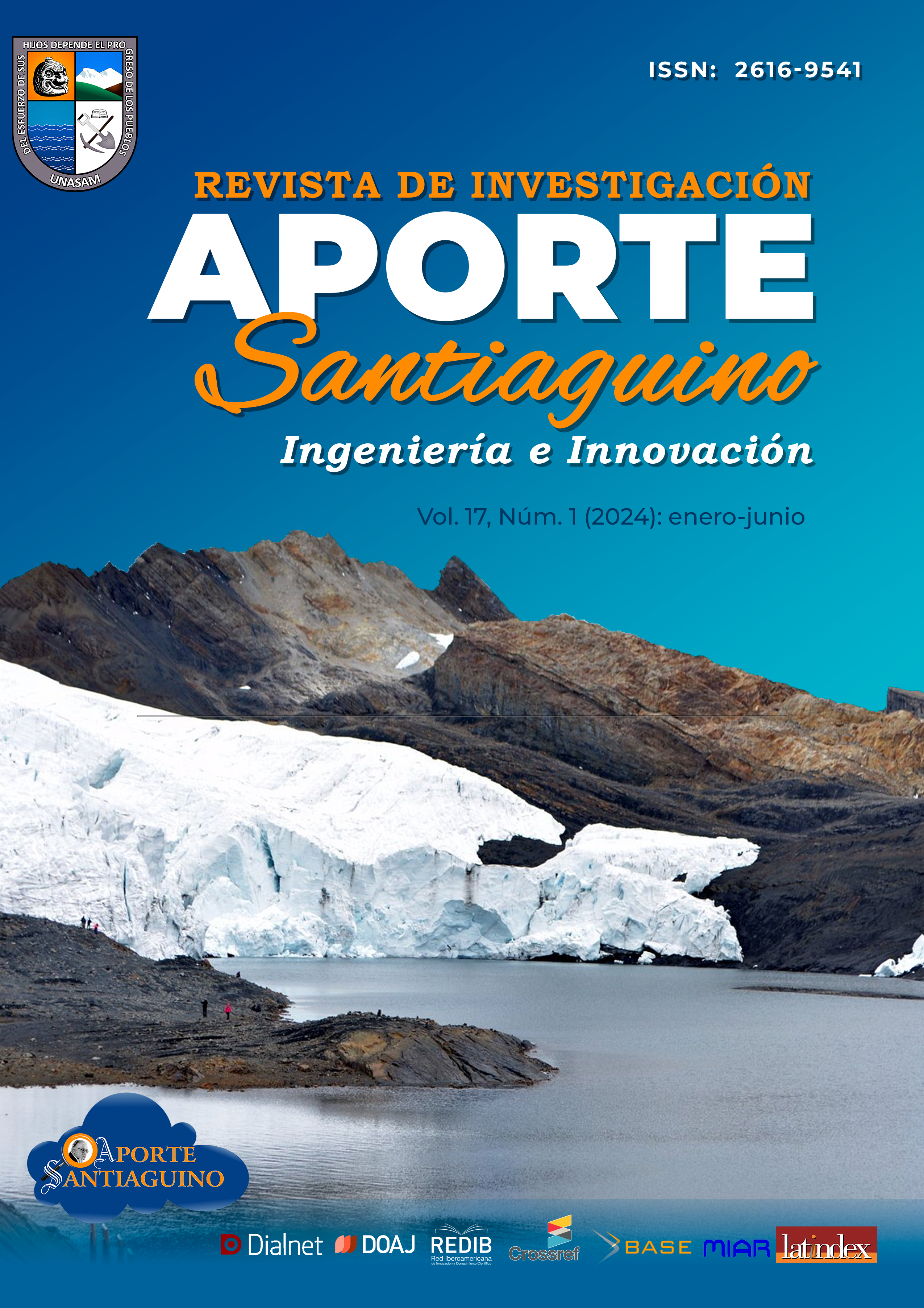Revisión de literatura para la estimación del volumen de lagunas glaciales en base a modelos empíricos
DOI:
https://doi.org/10.32911/as.2024.v17.n1.1153Palabras clave:
Estimación del volumen de lagunas glaciales, Modelos empíricos, Batimetría, GlofResumen
El calentamiento global está provocando la recesión y adelgazamiento alarmante de glaciares de montaña a nivel mundial. Esto conlleva el riesgo directo de inundaciones explosivas de lagos glaciales (GLOF) que desencadenarían desastres como deslizamientos de tierra, que representa una amenaza significativa para la seguridad de la población, infraestructuras locales y numerosas pérdidas de vidas humanas. La investigación tuvo como objetivo recopilar hallazgos de publicaciones entre los años 2010 y 2023 a través de una revisión de literatura en las bases de datos Scopus, ScienceDirect y Researchgate. Según las directrices de Prisma, el proceso de revisión se segmentó en cuatro etapas preliminares: identificación, selección, evaluación e inclusión. Los resultados de volumen y área del lago están bien correlacionados R2 = 0.91. Estos datos proporcionan una visión clara respecto de las metodologías para la estimación del volumen de lagunas. Se concluyó que las investigaciones ofrecen una visión profunda de las metodologías a lo largo de los años y han mejorado sus resultados teniendo correlaciones aceptadas. A su vez, proporcionan una base sólida para la estimación de volúmenes.
Descargas
Citas
Allen, Simon K et al. 2022. “Glacial Lake Outburst Flood Hazard under Current and Future Conditions: Worst-Case Scenarios in a Transboundary Himalayan Basin”: 3765–85. https://doi.org/10.5194/nhess-22-3765-2022.
Ashraf, Arshad, Rozina Naz, and Muhammad Bilal Iqbal. 2015. “Heterogeneous Expansion of End-Moraine Dammed Lakes in the Hindukush-Karakoram-Himalaya Ranges of Pakistan during 2001–2013.” Journal of Mountain Science 12(5), 1113–24. http://jms.imde.ac.cn DOI: https://doi.org/10.1007/s11629-014-3245-4
Bathymetric, Lake et al. “A New Digital Lake Bathymetry Model Using the Step-Wise Water Recession Method to Generate 3D.” https://doi.org/10.3390/w11061151
Cook, S. J., and D. J. Quincey. 2015. “Estimating the Volume of Alpine Glacial Lakes.” Earth Surface Dynamics 3(4): 559–75. https://doi.org/10.5194/esurf-3-559-2015
Drenkhan, Fabian, Lucía Guardamino, Christian Huggel, and Holger Frey. 2018. “Current and Future Glacier and Lake Assessment in the Deglaciating Vilcanota-Urubamba Basin, Peruvian Andes.” Global and Planetary Change 169(July): 105–18. https://doi.org/10.1016/j.gloplacha.2018.07.005
Duan, Hongyu et al. 2022. “Water Storage and Potential Hazard of Moraine-Dammed Glacial Lake in Maritime Glaciation Region A Case Study of Bienong Co.” (April). https://doi.org/10.5194/tc-17-591-2023
Duan, Hongyu et al. 2023. “Lake Volume and Potential Hazards of Moraine-Dammed Glacial Lakes a Case Study of Bienong Co , Southeastern Tibetan Plateau” 591–616. https://doi.org/10.5194/tc-17-591-2023
Dubey, Saket, and Manish Kumar Goyal. 2020. “Glacial Lake Outburst Flood Hazard, Downstream Impact, and Risk Over the Indian Himalayas.” Water Resources Research 56(4): 0–1. https://doi.org/10.3390/rs14235957
Emmer, Adam et al. 2021. “Glacier Retreat and Associated Processes since the Last Glacial Maximum in the Lejiamayu Valley, Peruvian Andes.” Journal of South American Earth Sciences 109(November 2020): 1–12. https://doi.org/10.1016/j.jsames.2021.103254
Fan, Xuanmei et al. 2022. “Imminent Threat of Rock-Ice Avalanches in High Mountain Asia.” Science of the Total Environment 836(April): 155380. https://doi.org/10.1016/j.scitotenv.2022.155380
Goswami, Uttam Puri, and Manish Kumar Goyal. 2021. “Assessment of Glacial Lake Development and Downstream Flood Impacts of Critical Glacial Lake.” Natural Hazards 109(1): 1027–46. https://doi.org/10.1007/s11069-021-04866-8
Islam, Nazimul, and Priyank Pravin Patel. 2021. “Inventory and GLOF Hazard Assessment of Glacial Lakes in the Sikkim Himalayas , India.” Geocarto International 0(0): 1–36. https://doi.org/10.1080/10106049.2020.1869332
Khan, Garee et al. 2021. “Expansion of Shishper Glacier Lake and Recent Glacier Lake Outburst Flood (GLOF), Gilgit-Baltistan, Pakistan.” Environmental Science and Pollution Research 28(16): 20290–98. https://doi.org/10.1007/s11356-020-11929-z
Khanal, Narendra Raj, Jin-ming Hu, and Pradeep Mool. 2015. “Glacial Lake Outburst Flood Risk in the Poiqu / Bhote Koshi / Sun Koshi River Basin in the Central Himalayas.” 35(4): 351–64. https://doi.org/10.1659/MRD-JOURNAL-D-15-00009
Ma, Jingsong, Chunqiao Song, and Yanjun Wang. 2021. “Spatially and Temporally Resolved Monitoring of Glacial Lake Changes in Alps During the Recent Two Decades.” Frontiers in Earth Science 9(August): 1–11. https://doi.org/10.3389/feart.2021.723386
Medeu, Akhmetkal R. et al. 2022. “Moraine-Dammed Glacial Lakes and Threat of Glacial Debris Flows in South-East Kazakhstan.” Earth-Science Reviews 229(February): 103999. https://doi.org/10.1016/j.earscirev.2022.103999
Mergili, Martin et al. 2020. “Reconstruction of the 1941 GLOF Process Chain at Lake Palcacocha (Cordillera Blanca, Peru).” Hydrology and Earth System Sciences 24(1): 93–114. https://doi.org/10.5194/hess-24-93-2020
Miaomiao Qi , Shiyin Liu , Kunpeng , Wu Yu Zhu, Fuming Xie , Huian Jin, Yongpeng Gao, Xiaojun Yao. 2022. “Improving the Accuracy of Glacial Lake Volume Estimation: A Case Study in the Poiqu Basin, Central Himalayas.” Journal of Hydrology Volume 610. https://doi.org/10.1016/j.jhydrol.2022.127973
Muñoz, Randy et al. 2020. “Glacial Lake Depth and Volume Estimation Based on a Large Bathymetric Dataset from the Cordillera Blanca, Peru.” Earth Surface Processes and Landforms 45(7): 1510–27. https://doi.org/10.1002/esp.4826
Qi, Miaomiao et al. 2022. “Improving the Accuracy of Glacial Lake Volume Estimation: A Case Study in the Poiqu Basin, Central Himalayas.” Journal of Hydrology 610. https://doi.org/10.1016/j.jhydrol.2022.127973
Qiao, Baojin et al. 2019. “Estimation of Lake Water Storage and Changes Based on Bathymetric Data and Altimetry Data and the Association with Climate Change in the Central Tibetan Plateau.” Journal of Hydrology 578(August): 124052. https://doi.org/10.1016/j.jhydrol.2019.124052
Rawat, Manish et al. 2023. “Glacial Lake Outburst Flood Risk Assessment Using Remote Sensing and Hydrodynamic Modeling : A Case Study of Satluj Basin, Western”: 41591–608. https://doi.org/10.1007/s11356-023-25134-1
Remya, S N, Anil V Kulkarni, S Pradeep, and D G Shrestha. 2019. “Volume Estimation of Existing and Potential Glacier Lakes, Sikkim Himalaya, India” 116(4). https://doi: 10.18520/cs/v116/i4/620-627
Schmidt, Susanne, Marcus Nüsser, Ravi Baghel, and Juliane Dame. 2020. “Cryosphere Hazards in Ladakh: The 2014 Gya Glacial Lake Outburst Flood and Its Implications for Risk Assessment.” Natural Hazards 104(3): 2071–95. https://doi.org/10.1007/s11069-020-04262-8
Serrano-ruiz, Julio C, Josefa Mula, and Raúl Poler. 2021. “Smart Manufacturing Scheduling : A Literature Review Smart Manufacturing Scheduling: A Literature Review.” Journal of Manufacturing Systems 61(November): 265–87. https://doi.org/10.1016/j.jmsy.2021.09.011
Sharma, R. K., Pranay Pradhan, N. P. Sharma, and D. G. Shrestha. 2018. “Remote Sensing and in Situ-Based Assessment of Rapidly Growing South Lhonak Glacial Lake in Eastern Himalaya, India.” Natural Hazards 93(1): 393–409. https://doi.org/10.1007/s11069-018-3305-0
Shrestha, Finu et al. 2023. “A Comprehensive and Version-Controlled Database of Glacial Lake Outburst Floods in High Mountain Asia” 7271187: 3941–61. https://doi.org/10.5194/essd-15-3941-2023
Wang, Shi Jin, and Shitai Jiao. 2015. “Evolution and Outburst Risk Analysis of Moraine-Dammed Lakes in the Central Chinese Himalaya.” Journal of Earth System Science 124(3): 567–76. https://doi.org/10.1007/s12040-015-0559-8
Yao, Xiaojun et al. 2012. “Volume Calculation and Analysis of the Changes in Moraine-Dammed Lakes in the North Himalaya: A Case Study of Longbasaba Lake.” Journal of Glaciology 58(210): 753–60. https://doi.org/10.3189/2012JoG11J048
Zhang, Taigang, Weicai Wang, and Baosheng An. 2023. “A Conceptual Model for Glacial Lake Bathymetric Distribution.” : 5137–54. https://doi.org/10.5194/tc-17-5137-2023
Zhu, Li Ping, Man Ping Xie, and Yan Hong Wu. 2010. “Quantitative Analysis of Lake Area Variations and the Influence Factors from 1971 to 2004 in the Nam Co Basin of the Tibetan Plateau.” Chinese Science Bulletin 55(13): 1294–1303. https://doi.org/10.1007/s11434-010-0015-8
Descargas
Publicado
Cómo citar
Número
Sección
Licencia
Derechos de autor 2024 Fidel Aparicio Roque, Michellei Alvarez Benaute

Esta obra está bajo una licencia internacional Creative Commons Atribución 4.0.





















